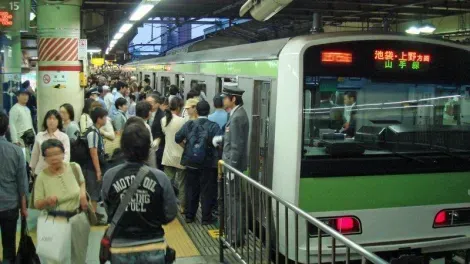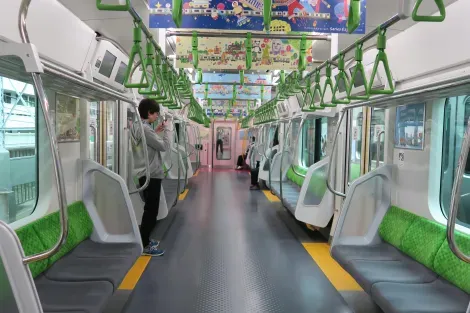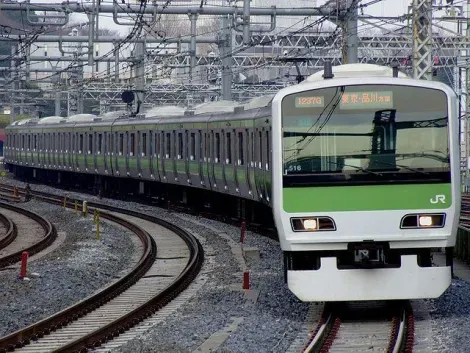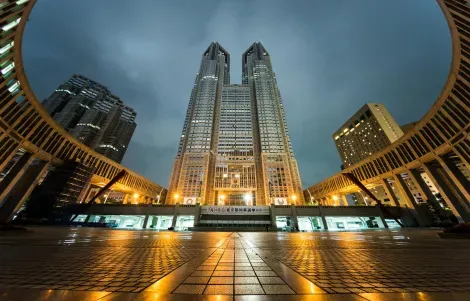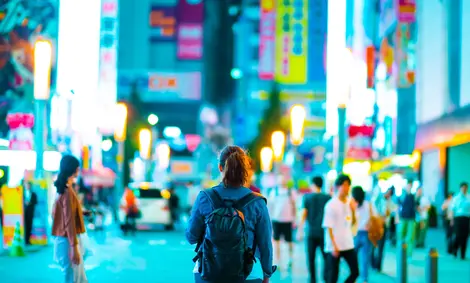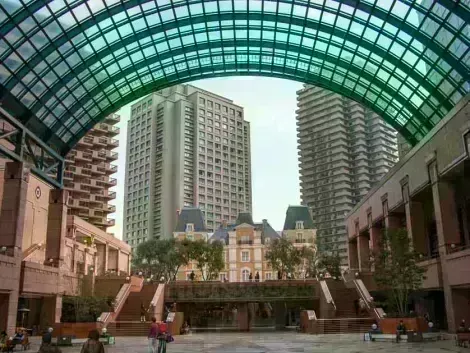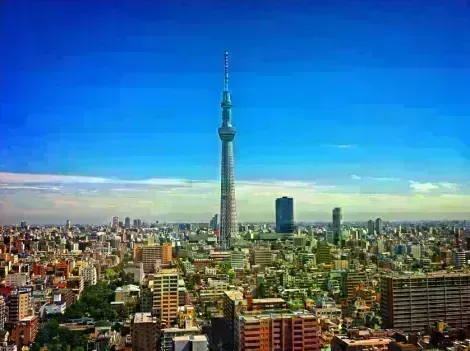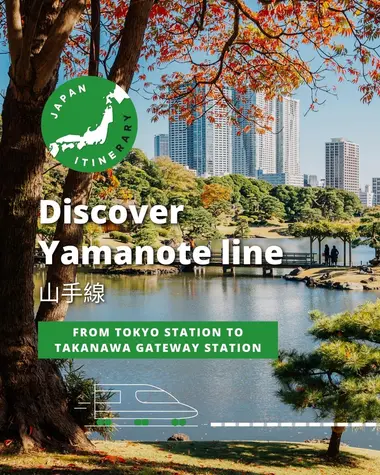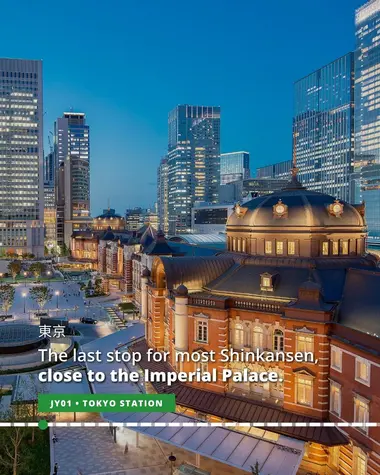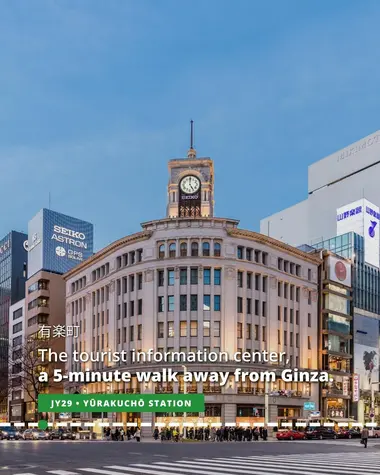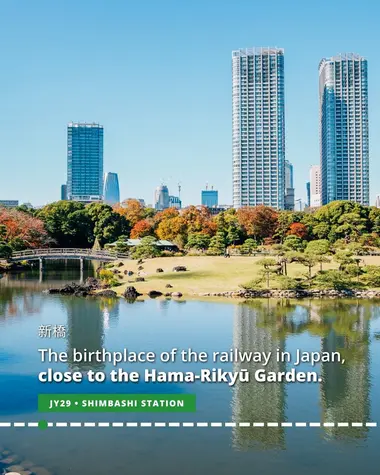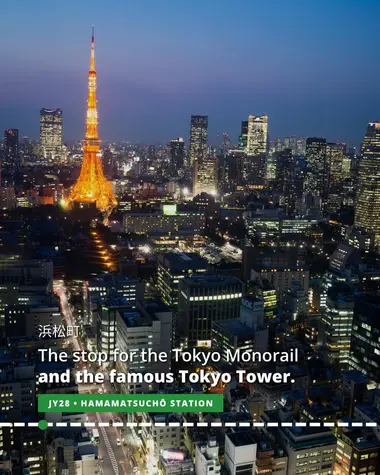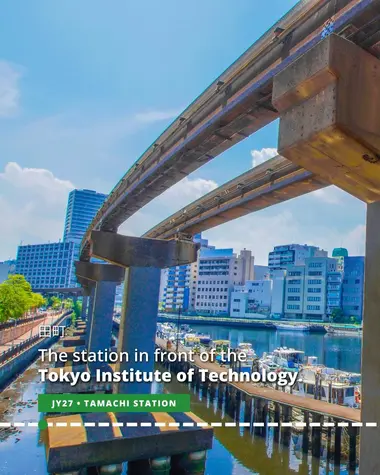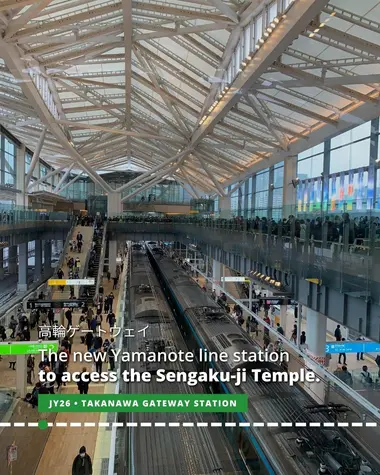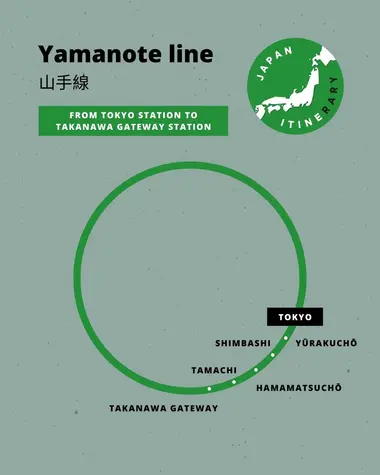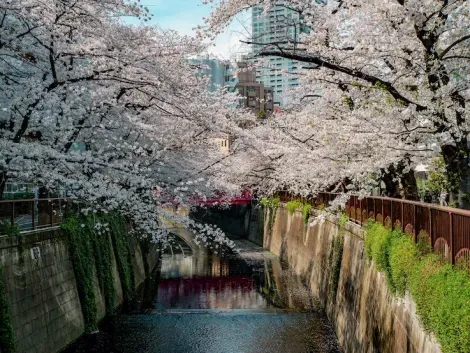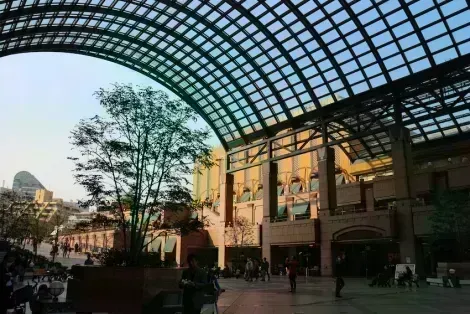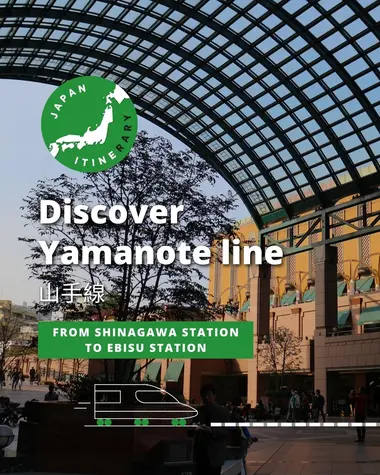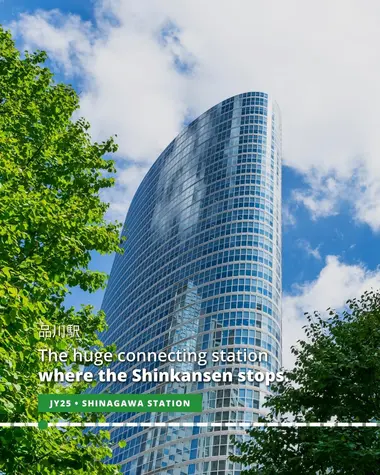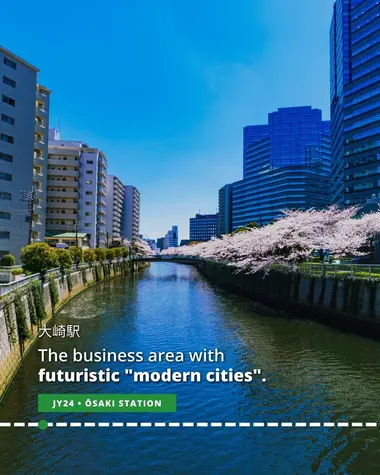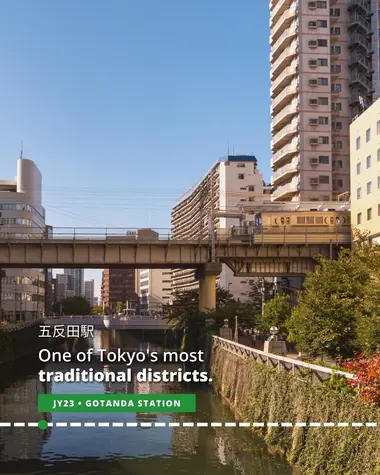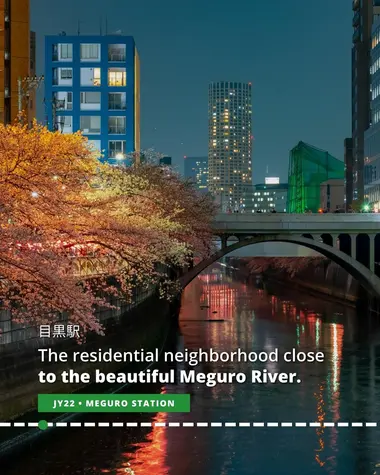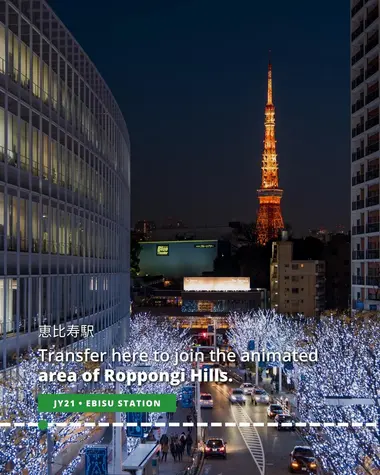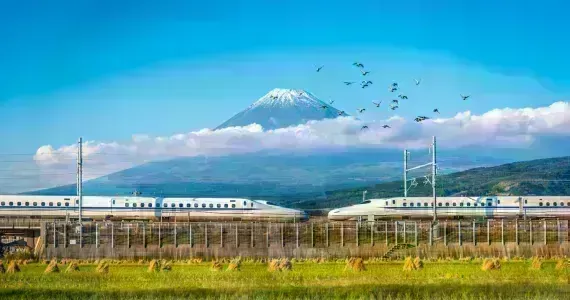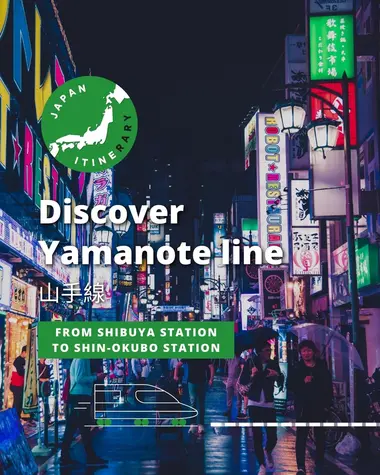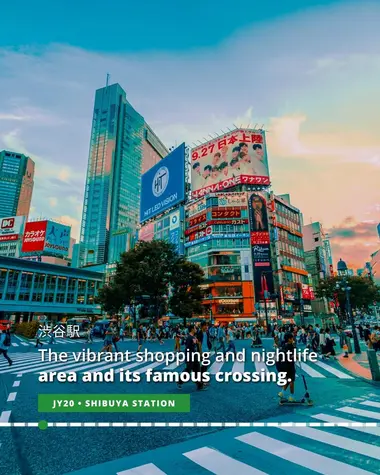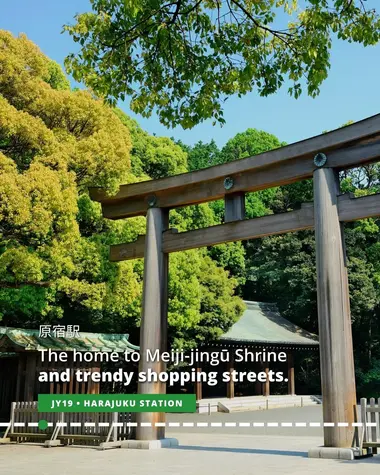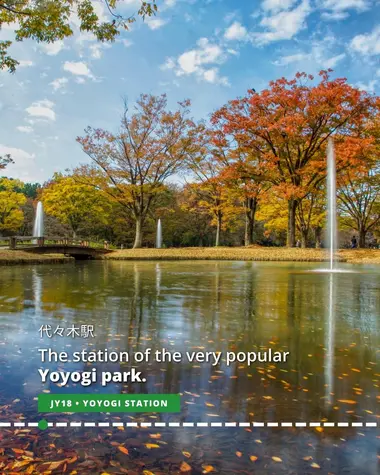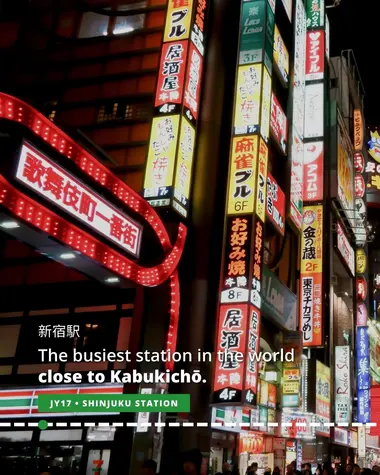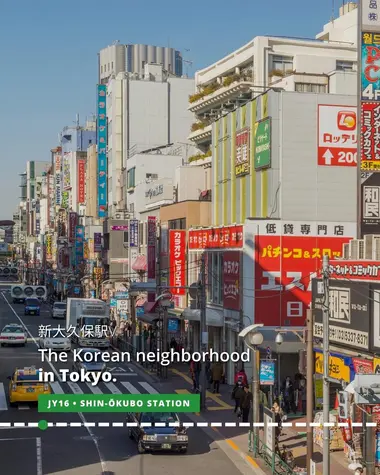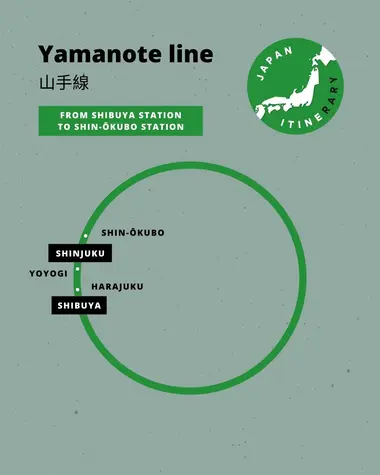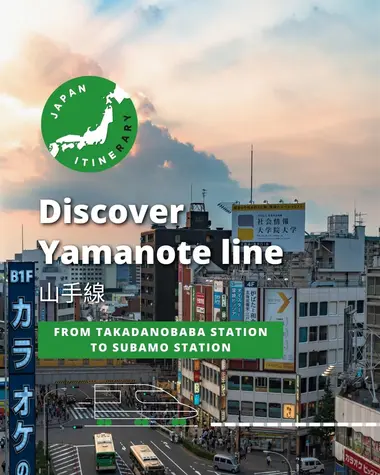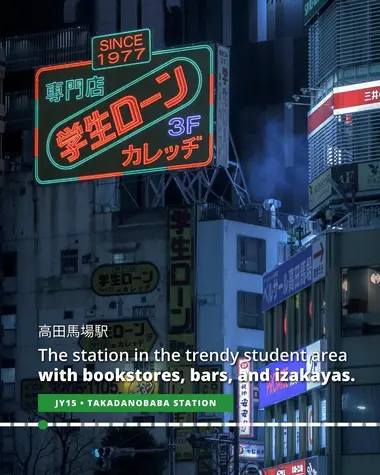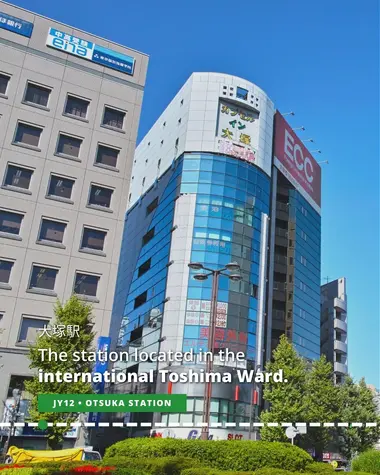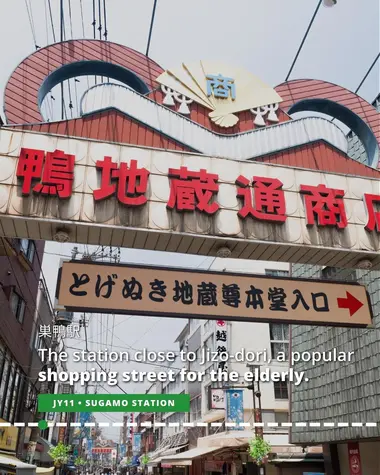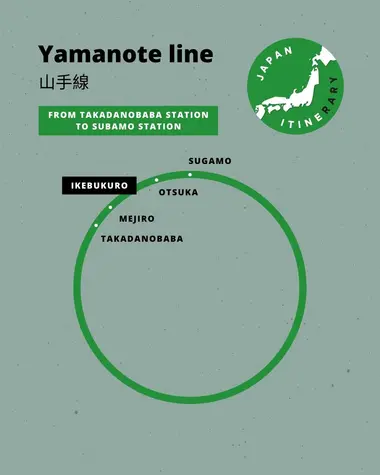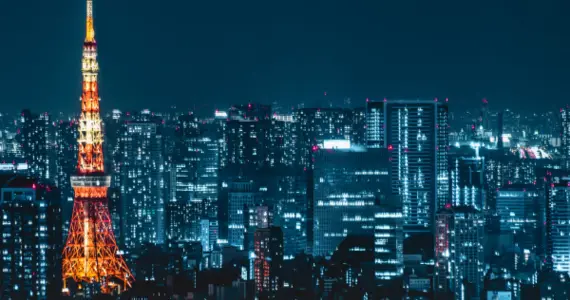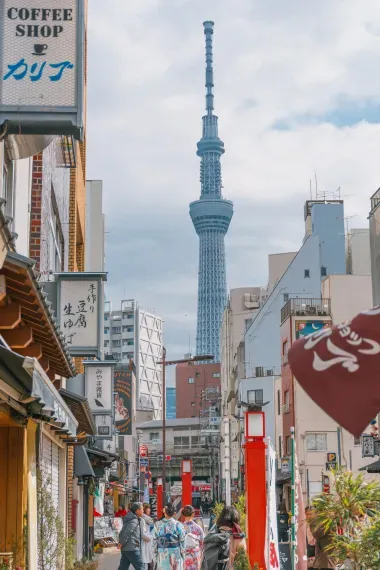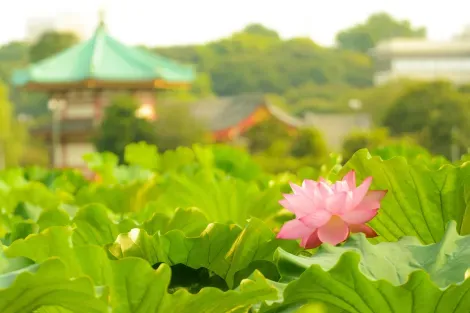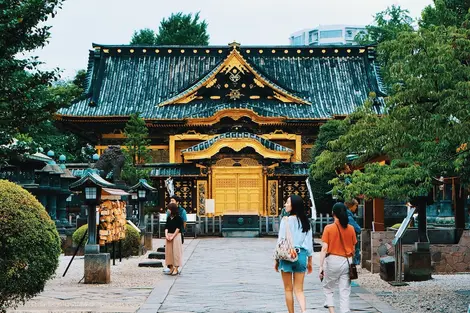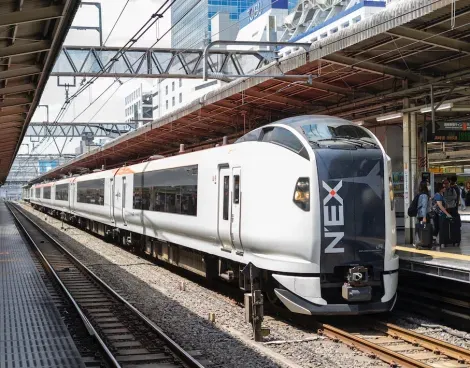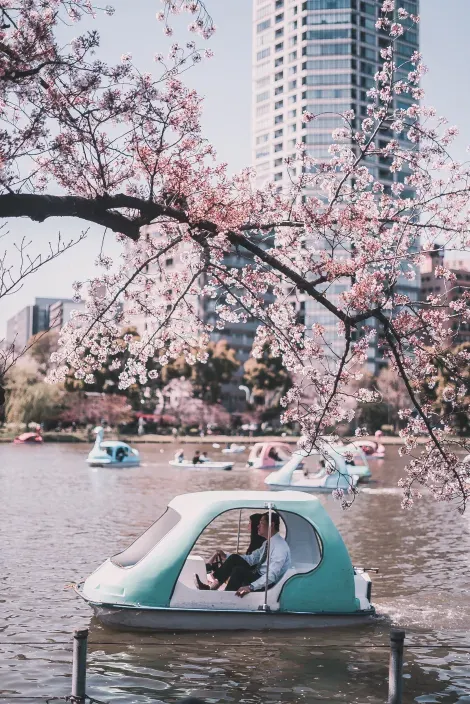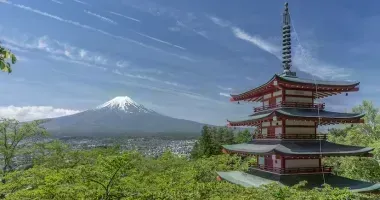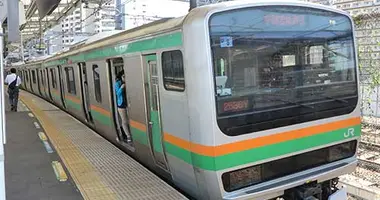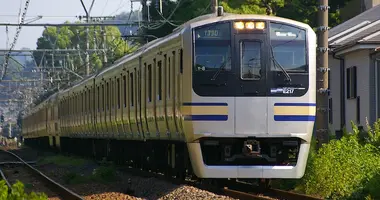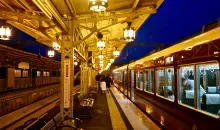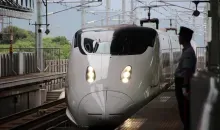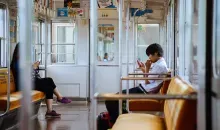The JR Yamanote Line
- Published on : 27/02/2023
- by : Japan Experience
- Youtube
Tokyo's most important train line
The JR Yamanote line runs in a loop around Tokyo; a full circuit takes about an hour. The trains can be recognized by its green color ; They are equipped with on-board colour screens above the doors telling you what is the next stop is, how long it will take to get there and which side of the train the exit door will be. The information are provided in both English & Japanese, thus making it one of the easier train line to navigate around Tokyo.
Tokyo's most important train line
The JR Yamanote Line runs in a loop around Tokyo, and a full circuit around the line takes about an hour. The trains can be recognized by their green color. They are equipped with on-board color screens above the doors, telling you what the next stop is, how long it will take to get there, and which side of the train the exit door will be on. The information is provided in both English and Japanese, as well as Korean and Chinese, thus making it one of the easier train lines to navigate around Tokyo.
Opened in 1885, the Yamanote Line has become essential to the daily lives of Tokyoites.
Passing all over Tokyo, it is the perfect line to travel there. It is a "circular" train line looping through the capital and passing through some of the city's most famous neighborhoods. Shibuya, Ikebukuro, Shinjuku, and Akihabara are all served by the Yamanote line.
The Yamanote line connects 30 different stations. It can be dentified via its green color and the letters JY. Each station is identified by a number; for example, Ikebukuro is designated as JY 13 and Shibuya as JY 20.
Is the Yamanote Line accessible to tourists?
The Yamanote Line is also very easy to use for travelers passing through Tokyo.
- Japan Rail Pass holders can take advantage of the line for free ;
- Information and instructions are systematically available in English in the carriages, on the platforms and in the station ;
- Important announcements are also made in English.
- The teams of the JR East company, in charge of the line, will be able to understand you and help you in your travels.
In short, this is the most accessible line in Tokyo for non-Japanese-speaking visitors.
Navigating the Yamanote Line
The Yamanote line travels 34.5 kilometers in one hour, with trains departing every two minutes during the day and every 30 seconds during rush hours. It is best to avoid rush hour on the Yamanote Line, especially, as it is very crowded, servicing the most prominent stations in Tokyo's center. The train service begins its service around 4.30 AM and runs until 1 AM the next day. Unlike train systems in other countries, one's in Japan do not run 24 hours, which is something those venturing out late at night in Tokyo should be aware of. To ensure the accurate operating time of the train line in Japan, we recommend you check the dedicated train travel phone application, Jorudan.
The train line is covered by the Japan Rail Pass, as well as other JR Lines in the city and all Shinkansen bullet train lines that go throughout Japan.
From Tokyo to Tamachi Stations
0 km - Tokyo Station
The city's namesake station is elegantly designed and surrounded by a number of high-end commercial establishments. Tokyo station is the terminus for most Shinkansen bullet train services and classic JR lines including the Tokaido-Sanyo Line, Hokuriku Shinkansen, and Tohoku Shinkansen.
The Tokaido-Sanyo will go to destinations such as Hakone, Nagoya, Kyoto, and Osaka. From there, it will extend out to Hiroshima then down to Hakata Station in Fukuoka City. Travelers going out to Takayama can make a transfer at Nagoya Station to ride the Hida Limited Express. The Hokuriku Shinkansen will go out to Tsuruga in Fukui and pass destinations such as Nagano, Toyama, and Kanazawa on the way. The Tohoku Shinkansen heads up north, right to the southern end of Hokkaido and passes by cities like Sendai in Miyagi, Fukushima, and Iwate.
The train station is divided into two parts: Marunouchi and Yaesu.
A short walk north-west from the Marunouchi exit of the station will lead you to the Imperial Palace and the Imperial Palace East Gardens. The palace is built on the site of the former Edo Castle. It was completed in 1888 and is now the residence of Emperor Akihito.
Most areas are not accessible to the public, but you can visit the East Gardens, which include a Japanese-style garden.
You can also walk to the National Museum of Modern Art, which displays the largest collection of modern Japanese art as well as Western-style paintings.
0.8 km - Yurakucho Station
Get off the train here for the tourist information center and take the International Forum exit.
A five-minute walk from Yurakucho Station is Ginza, considered the most fashionable shopping district in Japan.
Tsukiji Fish Market, the largest wholesale fish market in Japan, is two stops from Ginza on the Hibiya Subway Line. Visitor numbers for the auctions are limited. You have to queue at the O-sakana Fukyu Center before 5 AM. Alternatively, you can arrive after 9 AM to visit the wholesale market area.
2 km - Shimbashi Station
Shimbashi and Shimbashi Station are seen as the birthplace of the railway and the train system in Japan. At nearby Shiodome, you can visit the former Shimbashi Station, a replica of Japan's first train station building.
Hama Rikyu Garden is a 10-15 minute walk from the station. It is one of Tokyo's best-known landscape gardens and dates back 300 years.
3.1 km - Hamamatsucho Station
Change here for the Tokyo Monorail to Haneda Airport.
From here, also visit the 333-meter high (1093 feet) Tokyo Tower, which was constructed in 1958, when Tokyo's young TV networks needed a tall antenna to transmit. The Main Observatory is at 150 meters (492 feet) and the Special Observatory is at 250 meters. At the main observation floor cafe, Club 33 hosts free live music on Wednesday, Thursday, and Friday evenings.
The tower also houses an art gallery, the Guiness Book of World Records Museum Tokyo, and a wax museum. This is a great station for seeing some of Tokyo's most interesting attractions.
4.6 km - Tamachi Station
Just across the street from this station stands the Tokyo Institute of Technology.
Just after Tamachi Station, you will see the impressive site of the new Yamanote Station, Takanawa Gateway.
5.9 km - Takanawa Gateway Station
The new station along the Yamanote line will bring you to a new district. It gives also access to the temple Sengakuji and the Sengakuji subway station.
From Shinagawa Station to Ebisu Station
Shinagawa Station is in the south of central Tokyo in Minato Ward, just north of Shinagawa ward after which the station is named. Shinagawa Station is the first major rail station on the Tokaido Shinkansen south of Tokyo Station. Shinagawa station and its surroundings have been developed over the last decade. The station concourse is sleek and modern and contains a number of upmarket stores, including the Atre department store. The east and west sides of the station are quite different.
6.8 km - Shinagawa Station
Shinagawa Station is a stop for the Narita Express , the Tokaido Line, the Keihin-Tohoku Line, the Yokosuka Line, and the Sobu Line. It has also connections with the Shinkansen bullet train out to Kyoto Station and Shin-Osaka Station.
8.8 km - Osaki Station
This business district has developed rapidly over recent years. It has a very futuristic appearance with its many modern "cities," or cluster of buildings, including Osaki New City, Gate City Osaki, Art Village Osaki, and ThinkPark.
9.7 km - Gotanda Station
This district is one of the few in Tokyo that has retained much of its traditional character. Near the station, you will find the department stores Tokyu and Tokyo Outlet Center and several restaurants selling Korean barbeque. The Tokyo Design Center is situated just opposite Gotanda Railway Station. The Center is a landmark on the Tokyo skyline. Hara Museum of Contemporary Art is about a 10-minute walk from the station. The museum is Japan's oldest museum devoted to contemporary, international, and Japanese art.
10.9 km - Meguro Station
Meguro is a mainly residential area popular for its hilly landscape. A five-minute walk from Meguro Station is Daienji Temple. This small temple is steeped in history. It was at the center of the big fire in Edo that destroyed much of the city in 1772. There's a fair amount of nice restaurants and cafes within walking distance of the station as well.
12.9 km - Ebisu Station
This upscale station and the area around it were named after the line of beer produced by Sapporo, since it was the site of the drink's manufacturing plant. Nowadays, it is home to a number of luxury restaurants, including Joel Robuchon's and the Photography Museum. Yebisu Garden Place is also a popular spot. This station and area are not far from Shibuya, making it a popular commercial area that isn't too crowded.
Buy your JR Pass
From Shibuya to Shin-Okubo Stations
The JR Station is in the heart of the station. Two platforms are dedicated to the JR Yamanote Line (1 and 2), and two platforms (3 and 4) are for the Saikyo Line, the Shonan Shinjuku line, the Narita Express to Narita Airport, and the Zushi Line.
In the basement, many subway lines have connections: the Tokyu Toyoko Line, the Tokyu Den-en-toshi Line, the Tokyo Metro Hanzomon Line, and the Tokyo Metro Futukoshin Line.
14 km - Shibuya Station
This is a vibrant shopping and nightlife area and is home to more than a dozen department stores, including the Hikarie Complex, the Shibuya Stream, and two new shopping malls, the Shibuya Scramble Square and the Tokyu Plaza Shibuya (Fukuras).
Do not miss the lights changing at Shibuya Crossing, reported to be Japan's busiest crossing, nicknamed the "Times Square of Tokyo."
15.2 km - Harajuku Station
The station was renovated in 2019, and the new exit will bring you near the Meiji Jingu Shrine Entrance. Walk for 5 minutes to find the popular Yoyogi Park. The park is home to Meiji Jingu Shrine, opened in 1920 in honor of Emperor and Empress Meiji. The shrine is divided into the inner and outer gardens. In late May or June, you can see the blooming iris garden (inner garden, open daily from sunrise to sunset, free).
Harajuku is also a trendy shopping area (notably Omotesando Avenue), with plenty of restaurants, cafés, and alternative clothing and music stores.
16.7 km - Yoyogi Station
Yoyogi Park is next to the station and stands on the site where the first successful powered aircraft flight in Japan took place. The park was created in 1967. The park is very popular, particularly on Sundays and in spring, when thousands of people flock here to enjoy the cherry blossoms.
17.4 km - Shinjuku Station
It is considered the busiest station in the world. Head out of the West Exit to reach the Tokyo Metropolitan Government Building, Tokyo's city hall, comprised of three buildings. From the 45th floor of TMG No. 1, visitors can get spectacular views from the north and south towers. You can also find the Tokyo Tourist Information Center on the first floor.
North-east of Shinjuku Station is an area called Kabuki-cho, an area noted for its nightlife, with many strip clubs, massage parlors, adult stores, bars, and restaurants.
Shinjuku as a whole, however, is notable for its many commercial areas and even has quieter streets that are hidden amongst the busy main roads and avenues.
From Shinjuku Station, there are a medley of other JR Lines that can be ridden, not just to other parts of the city, but a number of destinations throughout Japan.
From Takadanobaba to Sugamo Stations
JR Takadonobaba Station was put into operation on September 15, 1910, while Seibu Station opened on April 16, 1927, and the Tōzai Line station on December 23, 1964. It sees an average of 680,000 passengers per day and is the 11th busiest station on the JR network in the capital. Its proximity to the great Waseda University is one reason.
20.1 km - Takadanobaba Station
This area, also known as Baba, is a trendy student area located close to Waseda University, Gakushuin University, and several other vocational and training schools. There are many bookstores, cheap bars, and izakayas (Japanese drinking establishments that also serve food).
It is also home to the famous Astro Boy, a manga series first published in 1952, created by Osamu Tezuka.
21 km - Mejiro Station
One of the smaller stations of the Yamanote Line, with just one island platform. To the right of the station is the Gakushuin University campus, and on the left is a busy shopping street with a wide variety of shops and restaurants.
22.2 km - Ikebukuro station
This is the working person's Tokyo and is filled with shopping malls and department stores, notably Seibu and Tobu, two of the country's largest department stores. It's also rich with Izakayas, bars, and other restaurants, along with pockets of quieter, residential streets.
24 km - Otsuka Station
This station is located in the Toshima Ward, one of the most international wards in Tokyo. It is mainly known for its Awa Dance Festival, the second largest Awa Odori dance festival in Tokyo. It is held every year between the 12th and the 15th of August.
25.1 km - Sugamo Station
Jizo-dori, a popular shopping street for the elderly, is located just to the north of the station. During the Edo Period, the street was part of the Nakasendo Highway that connected Edo (now Tokyo) to Kyoto.
From Komagome to Uguisudani Stations
Komagome is about nature, a unique Yamanote Line station with borders of beautiful gardens as soon as you set foot on its quay with the many azalea bushes that are arranged on each side. When they bloom each spring, the view is magnificent from the station!
Komagome Station was built on November 15, 1910, on the heights to the east of Toshima District. It is served by the JR Yamanote Line as well as the Tokyo Metro Namboku Line. Komagome is a small station, very quiet, in a neighborhood that is just as quiet although it does not lack attractions.
25.8 km - Komagome Station
During the 17th to 19th centuries, feudal lords of Edo built their residences here, and the area has retained much of the Edo charm. Komagome is best known for its greenery and many parks.
The best known garden of the area is Rikugien, which was created in the second century. It is a traditional Japanese garden with a central pond, with islands, viewing hills, strolling paths, and several wooden teahouses where you can relax and enjoy some good matcha tea.
Kyu-Furukawa Garden is also located near Komagome Station. The garden was created in 1914 and is composed of two parts: the Western style house and its garden in front, and the Japanese garden.
Discover Tokyo with a guide
28.2 km - Nishi-Nippori Station
This is a traditional and relaxed area of Tokyo, with many temples, cemeteries, and small shops and restaurants not far from the station.
Visit Tennoji Temple, founded more than 500 years ago. The first thing you see upon entering the compound is a seated bronze Buddha, which dates from 1690 and is one of the temple's most valuable treasures.
Yanaka Cemetery was once the burial grounds of Kane-ji and Tennoji temples and was opened to the public in 1874. It is one of Tokyo's largest cemeteries. Among its more than 7,000 tombstones are those belonging to famous public figures, artists, and writers.
27.4 km - Tabata Station
The opening of the Tokyo School of Fine Arts in Ueno attracted many young artists to Tabata, and well-known and aspiring writers alike also moved to the area.
The Tabata Memorial Museum of Writers and Artists, which is just a two-minute walk from the station, displays items by and related to the former writers and artists who lived there.
28.7 km - Nippori Station
This is a good spot for trainspotting, as both JR and Keisei private line trains pass through here.
Nippori is one of the few areas where you may be able to see Mount Fuji without having to go up a tower. It is also the fabric district of Tokyo, where you can find the traditional fabrics used for kimono.
Change here for access to Narita Airport on the Keisei Skyliner.
29.8 km - Uguisudani Station
Until WWII, this was a popular geisha quarter, but it is now known for its nightlife.
Some older wooden houses still remain in its narrow streets, and the area is also home to the Tokyo National University of Fine Arts and Music and its art museum. As well as the works of famous artists and craftsmen, the collection also includes items by university teachers and students. With over 28,000 artifacts, the University Art Museum today has the largest collection of art objects in all of Japan.
From Ueno Station to Tokyo Station
The Ueno district is rich in history. In 1868, it was a place of resistance for the last samurai, some two thousand followers of the Tokugawa shogun, who were fighting against the imperial troops. In 1883, the Ueno station opened the doors of the capital to northern Japan and, for a long time, remained the busiest station in the country.
30.9 km - Ueno Station
Ueno Station is an important railway junction. Shinkansen bullet trainservices stop here, and it is the nearest stop to connect with the Ginza subway line.
Just outside the station, you will find Ueno Park, which is one of the largest parks in Tokyo and very popular with families. The park is especially popular in the cherry blossom season, when Tokyoites come to sit, contemplate the cherry blossoms, and drink beer and saké.
The park is home to: the Tokyo National Museum, the oldest and largest museum in Japan; the Ueno Zoo, founded in 1882; it is the oldest zoo in Japan. It is home to Li-li and Shin-Shin, two pandas on loan from China; the Shitamachi Museum, featuring recreated homes and stores from the Edo and Taisho periods.
Change here for the Ginza Line and alight at the last stop to visit the Asakusa district, which is rich in history and tradition and is the sight of the famous Sensoji Temple.
31.5 km - Okachimachi Station
This station is located near Ameyoko, a busy market street. The name is short for "Ameya Yokocho" (candy store alley), as candies were traditionally sold here. Today, various products such as clothes, bags, cosmetics, fresh fish, dried food, spices, and much more are on sale.
32.5 km - Akihabara Station
Akihabara Station has long been the shopping destination for electronics and electrical appliances. In recent years, Akihabara has also become a mecca for otaku culture and home to anime and manga stores, along with a medley of themed maid cafes. But one of Akihabara's best features, especially for locals, is its notable Izakaya Street, with many delicious shops and open-air establishments lining the street.
33.2 km - Kanda Station
This district is known for its second-hand bookstores. Kanda is one of the most definitive "shita-machi" towns in Tokyo, more residential and down-to-earth than central parts of Tokyo, but filled with unique spots to check out.
34.5 - Tokyo Station
From Tokyo station, the Narita Express takes 53 minutes to reach Narita Airport.




